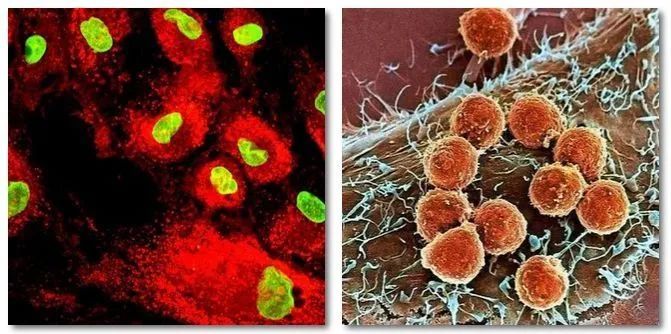The human body is the kingdom of cells, there are about 40 trillion to 60 trillion human cells, these cells make up the body's various systems. Every human activity, even the simplest blink of an eye, requires the concerted efforts of millions of cells. They are constantly evolving, highly sophisticated and highly organized. Any GREAT KINGDOM NEEDS both CAPABLE BUILDERS AND VALIANT DEFENDERS, and OUR BODY CELL KINGDOM is no exception. Stem cells are builders and immune cells are defenders.

Stem cells (left) and immune cells (right)
01.The difference between the two functions
While our bodies are still growing, stem cells are the builders of the cell kingdom, increasing the number of cells in our bodies by providing a constant stream of new cells through differentiation. When our bodies stop growing as adults, stem cells act as the maintainers of the cell kingdom, replacing and renewing old or damaged cells.
When foreign enemies invade, such as bacteria and viruses, the immune cells act as armies of the cell kingdom, responding quickly to remove them.
If there is a renegade molecule in the cell kingdom, such as a normal cell mutating into a cancer cell, the immune cells act as a security system to recognize and remove it.
02.The difference between the two categories
Stem cells and immune cells are classified differently because of their different functions.
Stem cell classification
If the human body is compared to a tree, the seed buried deep in the earth is a potent stem cell, which can differentiate into a complete human body, just as the seed can grow into a towering tree.
The main branches of big trees can be likened to pluripotent stem cells, mainly including subtopotent stem cells and mesenchymal stem cells, which can differentiate into nerve cells, cardiomyocytes, hepatocytes, osteoblasts and other multi-system functional cells, just like the luxuriant branches, leaves and fruits produced by each tree crown.
The terminal stem cells are specialized stem cells, such as hematopoietic stem cells, which can only differentiate into red blood cells, white blood cells, platelets, etc. of the blood system, just as the terminal stem can grow leaves and fruits.
Immune cell classification
At present, natural killer cells (NK cells), cytokine-induced killer cells (CIK) and recently CAR-T cells are widely used in clinical practice.
NK cells are indispensable innate immune cells in human bone marrow, which can directly remove senescent cells and indirectly activate phagocytes and T cells to increase the clearance of viruses.
CIK cells can further enhance their own immunity and make up for the relative shortage of NK cells, just like the armed police are needed to help when there are too many bad guys.
CAR T cells are immune T cells modified with tumor protein genes. While tumor cells are hunted by NK and CIK cells, some tumor cells learn to disguise themselves in the war and are no longer recognized by NK and CIK cells. The result is CAR-T, which targets and kills these slyly disguised tumor cells. As a result, the CAR T is like an army with a clear mission to completely annihilate the enemy.
03.Different extraction methods
Stem cells can be derived from a variety of human tissues. At present, the most widely used clinical mesenchymal stem cells, for example, are initially extracted from bone marrow, and later can be extracted from blood, fat, dental pulp and other human tissues. Fifteen years ago, in 2004, scientists discovered that the most abundant and high-quality natural source of mesenchymal stem cells is the placenta, which is often discarded.
At present, the main source of immune cells is blood, including peripheral blood of adults and umbilical cord blood of infants. Blood contains a large number of functional mature immune cells, in our body constantly circulating, always protect our health.
04.The difference between the two applications
Immune cells
● Remove senescent cells and prevent disease
● Enhance human immunity
Stem cells
● Tissue repair
● Chronic diseases,
● Anti-aging.
05.future
The 21st century is the era of cell therapy. In the future, the application of stem cells and immune cells will become a common means in clinical treatment. Appropriate supplementation of high-quality cells will create infinite possibilities for enjoying the development of future medicine.